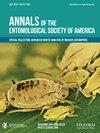修正:营养生态驱动食蚜昆虫(鞘翅目和锦翅目)和食蚜昆虫(夜蛾科,鳞翅目)丰度的年变化:来自光诱器的证据
IF 1.8
3区 农林科学
Q1 ENTOMOLOGY
引用次数: 0
摘要
利用捕食性神经翅目(Chrysopidae,13种)和鞘翅目(Coccinellidae,10种)以及植食性鳞翅目(Noctuide,79种)17年来的每日光捕记录,我们检验了一个假设,即食饵不规则且局部发生的食蚜蝇的捕获量年度波动范围大于植食性,其饮食规律且丰富。以去趋势年渔获量的方差系数(以平均值的百分比表示的标准差)来衡量的年渔获量的波动范围,金蝇科(84±7.1%)和球虫科(121±14.0%)明显大于夜蛾科(66±2.6%)前者和仅由那些特征(丰度、飞行期的长度和时间、每个季节的世代数、越冬阶段)与食蚜蝇相同的物种组成的夜蛾科样本。同样,在具有类似于食蚜蝇的特征(丰度、电压性、飞行活动期)的夜蛾科物种组和具有相反特征的夜蛾科物种组之间也没有发现差异。食蚜蝇的飞行能力比夜蛾科的小。由于这种差异,光阱从比夜蛾科更小的区域收集食蚜蝇种群。因此,食蚜和植食性物种的捕获量波动程度既受食物可获得性的年度差异的影响,也受聚集到光源的个体所处区域大小的差异的影响。本文章由计算机程序翻译,如有差异,请以英文原文为准。
Correction to: Trophic Ecology Drives Annual Variation in Abundance of Aphidophagous (Coccinellidae, Coleoptera and Chrysopidae, Neuroptera) and Phytophagous (Noctuidae, Lepidoptera) Insects: Evidence From Light Traps
Using seventeen-year records of daily light trap catches of predatory Neuroptera (Chrysopidae, 13 species) and Coleoptera (Coccinellidae, 10 species), and of phytophagous Lepidoptera (Noctuidae, 79 species) we tested a hypothesis predicting that the range of annual fluctuations of catch size is greater in aphidophages, whose diet occurs irregularly and locally, than in phytophages, whose diet is available regularly and abundantly. The ranges of fluctuations of annual catches measured as the coefficient of variance (standard deviation expressed as a percentage of the average) of detrended annual catches were significantly greater in Chrysopidae (84 ± 7.1%) and Coccinellidae (121 ± 14.0%) than in Noctuidae (66 ± 2.6%). The difference between aphidophages and phytophages remained when we tested differences between the former and the samples of Noctuidae consisting only of those species whose characteristics (abundance, length and timing of flight period, number of generations per season, overwintering stage) were the same as in aphidophages. Similarly, no differences were found between sets of Noctuidae species that have characteristics (abundance, voltinism, period of flight activity) similar to aphidophages and sets of Noctuidae species that have contrary characteristics. Flight abilities of aphidophages are smaller than those of Noctuidae. As a result of this difference a light trap collects populations of aphidophages from a smaller area than populations of Noctuidae. Thus the extent of fluctuations of catch size of aphidophagous and phytophagous species is influenced both by annual differences in food availability and by differences in size of the area from which the individuals assembling to the light source are recruited.
求助全文
通过发布文献求助,成功后即可免费获取论文全文。
去求助
来源期刊
CiteScore
4.90
自引率
0.00%
发文量
25
审稿时长
6-12 weeks
期刊介绍:
The Annals of the Entomological Society of America exists to stimulate interdisciplinary dialogue across the entomological disciplines and to advance cooperative interaction among diverse groups of entomologists. It seeks to attract and publish cutting-edge research, reviews, collections of articles on a common topic of broad interest, and discussion of topics with national or international importance. We especially welcome articles covering developing areas of research, controversial issues or debate, and topics of importance to society. Manuscripts that are primarily reports of new species, methodology, pest management, or the biology of single species generally will be referred to other journals of the ESA. The most important criteria for acceptance are quality of work and breadth of interest to the readership.

 求助内容:
求助内容: 应助结果提醒方式:
应助结果提醒方式:


